The United States Postal Service is planning to raise prices on many of its products by as much as 6.9% this summer as part of Postmaster General Louis DeJoy’s “Delivering for America” plan, an austerity plan which will aim to save the beleaguered service $160 billion over the next decade.
The changes announced Friday, which would take effect in late August, would see the price of a first-class stamp raised to 58 cents from 55 cents, an increase of 6.8% “to offset declining revenue due to First-Class Mail volume declines,” the USPS said in a release.
“For the past 14 years, the Postal Service has had limited pricing authority to respond to changing market realities,” DeJoy said in a statement. “As part of our 10-year plan to achieve financial sustainability and service excellence, the Postal Service and the Board of Governors are committed to judiciously implementing a rational pricing approach that helps enable us to remain viable and competitive and offer reliable postal services that are among the most affordable in the world.”
The USPS notes that the U.S. is far below the average of what it costs to mail a letter in other countries, even after the increase. According to the postal service, mailing a letter costs 77 cents in Japan, 86 cents in Australia, 89 cents in Canada, nearly a dollar in Germany, $1.20 in the U.K., $1.90 in France and $3.40 in Italy. The international average is $1.32.
According to the USPS, mail volume has dropped by 28% over the last 10 years — 46 billion pieces — and continues to decline.
Domestic postcards would now cost 40 cents to mail, up from 36, and the cost of outbound international letters would increase a dime, to $1.30.



